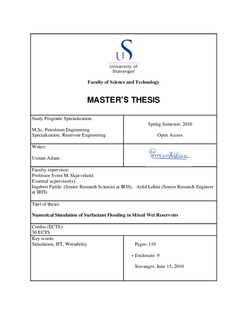| dc.contributor.author | Aslam, Usman | |
| dc.date.accessioned | 2010-10-20T14:23:21Z | |
| dc.date.available | 2010-10-20T14:23:21Z | |
| dc.date.issued | 2010 | |
| dc.identifier.uri | http://hdl.handle.net/11250/183259 | |
| dc.description | Master's thesis in Petroleum engineering | en_US |
| dc.description.abstract | Surfactants have been considered for enhanced oil recovery either by reduction of oil–water interfacial tension (IFT) or through wettability alteration. This study reveals the effect that reduced interfacial tension has on capillary trapping in heterogeneous reservoirs. This effect has been investigated by running numerical experiments on different synthetic simulation models. Rock capillary pressure is assumed to scale with IFT. Capillary contrast on the scale of a few centimeters to few tens of meters is reduced in the presence of surfactant. This reduction in IFT potentially may result in increased or accelerated oil production from mixed–wet reservoirs.
The main focus of this study is to simulate the displacement process (water flood) at various IFT using Eclipse (Surfactant Model). Simulation studies of different mechanisms which are believed to occur in mixed–wet reservoirs are presented. The surfactant flooding model was applied to the synthetic reservoir models. Simulation results indicate that surfactant flooding has a promising effect on the oil recovery depending upon the types of reservoir.
Detailed fine–scale simulation is carried out with representative relative permeability and imbibitions capillary pressure curves from mixed–wet cores. The efficiency of the surfactant flooding is investigated through sensitivity scenarios on formation rock/fluid parameters (e.g., Permeability, IFT, Flow Rate etc). It was found that the geological heterogeneity (layering, inclusions), imbibitions capillary pressure curve from mixed–wet reservoirs, viscous/capillary balance (Nc), gravitational forces, all have an impact on recovery by surfactant flooding. Lx/Lz (Length to thickness ratio of the model/ reservoir), permeability, IFT, density difference between oil and water and injection flow rates were found to be the critical parameters which influence simulation results. | en_US |
| dc.language.iso | eng | en_US |
| dc.publisher | University of Stavanger, Norway | en_US |
| dc.relation.ispartofseries | Masteroppgave/UIS-TN-IPT/2010; | |
| dc.subject | petroleumsteknologi | en_US |
| dc.subject | reservoarteknologi | en_US |
| dc.subject | simulation | en_US |
| dc.subject | IFT | en_US |
| dc.subject | wettability | en_US |
| dc.title | Numerical simulation of surfactant flooding in mixed wet reservoirs | en_US |
| dc.type | Master thesis | en_US |
| dc.subject.nsi | VDP::Technology: 500::Rock and petroleum disciplines: 510 | en_US |
| dc.source.pagenumber | 119 p. | en_US |
